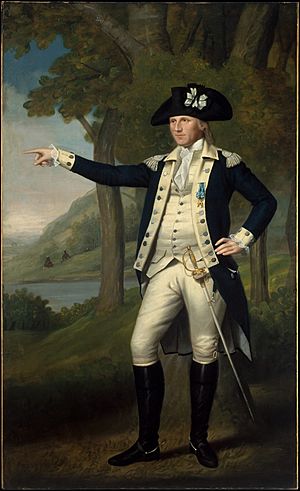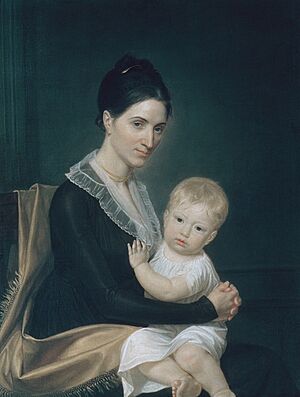Marinus Willett facts for kids
Quick facts for kids
Marinus Willett
|
|
|---|---|
 |
|
| 48th Mayor of New York City | |
| In office 1807–1808 |
|
| Preceded by | DeWitt Clinton |
| Succeeded by | DeWitt Clinton |
| Personal details | |
| Born | July 31, 1740 Jamaica, Queens |
| Died | August 22, 1830 (aged 90) New York City, New York |
| Political party | Anti-Federalist Party Democratic Republican |
| Spouses | Mary Pearsee (m. 1760) Susannah Vardill (m. 1793) Margaret Bancker (m. 1800) |
| Children | 6 |
| Profession | Military officer, politician |
| Military service | |
| Allegiance | (1754–1763) (1776–1783) |
| Branch/service | (1754–1763) (1776–1783) |
| Rank | Colonel |
| Unit | 1st New York Regiment 3rd New York Regiment 5th New York Regiment Tryon County militia |
| Battles/wars | |
Colonel Marinus Willett (born July 31, 1740 – died August 22, 1830) was an important American military leader and politician. He served as the Mayor of New York City from 1807 to 1808. Willett is best known for his brave actions during the American Revolution. He was a key Patriot leader in New York before joining the Continental Army. He fought in many battles during the Revolutionary War.
Born in Jamaica, Queens, Willett first trained as a cabinetmaker. He then joined the local militia when the French and Indian War started in 1754. He took part in the Ticonderoga campaign and helped capture Fort Frontenac in 1758. After getting sick, he recovered at Fort Stanwix. Later, he studied at King's College in New York, graduating in 1776.
In the 1770s, Willett joined the Sons of Liberty, a group that fought for American rights. In 1775, he joined the 1st New York Regiment. He was part of the Quebec invasion, which was not successful. In 1776, he moved to the 3rd New York Regiment. He fought in the Battle of Monmouth and later in the Sullivan Expedition in 1778. By 1780, he became a colonel of the 5th New York Regiment. In 1781, he led the Tryon County militia and fought at Johnstown. His soldiers left the army in 1783, ending his military career.
After the war, Willett returned to New York and became a merchant. He joined the Anti-Federalist Party. In 1783, he was elected to the New York State Assembly. He also worked as the Sheriff of New York County at different times. He served as New York City's mayor for one year. Marinus Willett died on August 22, 1830, and was buried in Trinity Church. The town of Willet, New York, is named after him.
Contents
Early Life and First Military Service
Marinus Willett was born on July 31, 1740, in Jamaica, Queens, New York. His father, Edward Willett, owned a tavern in colonial New York. His mother was Aleta Willett. As a young person, Marinus learned the trade of a cabinetmaker.
When the French and Indian War began in 1754, Willett joined the New York provincial militia. He was a lieutenant under the command of Oliver De Lancey. Willett fought in the Ticonderoga campaign in July 1758. He also helped in the British capture of Fort Frontenac in August 1758.
Later that year, he became ill and was sent to Fort Stanwix to get better. After the war ended in 1763, Willett went back to New York City. He later enrolled in King's College in 1772 and finished his studies in 1776.
As problems grew between Great Britain and its colonies in North America, Willett supported the Patriot cause. He became an important leader of the Sons of Liberty in New York City. During this time, he helped convince colonists to support the Patriots. He did this by speaking out and organizing protests.
Marinus Willett in the American Revolutionary War
When news of the battles of Lexington and Concord reached New York City on April 23, 1775, Willett took action. He and other Patriots broke into the city's arsenal and took weapons. On June 6, when the British briefly left New York City, Willett helped stop a military convoy from leaving. On June 20, he was part of a successful raid on a British storehouse in Turtle Bay, Manhattan.
Joining the Continental Army
On June 28, 1775, Willett joined the Continental Army as a captain in the 1st New York Regiment. Six weeks later, his regiment joined Richard Montgomery's invasion of Quebec. This included the difficult Battle of Quebec on December 31, 1775. After returning to New York, Willett fought in the American defeat at the Battle of Long Island on August 26, 1776.
In November 1776, Willett became a lieutenant-colonel in the 3rd New York Regiment. This regiment was led by Peter Gansevoort. Willett worked as Gansevoort's aide-de-camp, helping him in the New York Highlands. He helped recruit new soldiers and train them. In mid-1777, Gansevoort and Willett arrived at the old Fort Stanwix. They fixed it up and quickly set up a group of soldiers there.
Key Battles and Campaigns
In June 1778, Willett received permission to join George Washington's army. He then fought in the Battle of Monmouth on June 28. Willett also took part in an expedition against the Onondaga people in April 1778. He returned to his regiment and saw action in the Sullivan Expedition in May 1779. This expedition was against the Iroquois who were allied with the British.
In early 1780, Willett was made a colonel of the 5th New York Regiment. He served in this regiment until it was disbanded on January 1, 1781. In April 1781, he was appointed colonel of the Tryon County militia. With this militia, Willett won a victory over a British-Indian force at Johnstown on October 25. After an attempt to capture Fort Ontario failed, Willett's men left the army in 1783. This brought his military career to an end.
Political Career and Later Life
After the war, Willett returned to New York City and became a merchant. He also became involved in politics with the Anti-Federalist Party. He was a political advisor to George Clinton, a well-known New York statesman. They often discussed ways to balance the power of the Democratic-Republican Party. In December 1783, Willett was elected to the New York State Assembly. He also served as the Sheriff of New York County at different times.
In 1790, George Washington, who was then the U.S. President, sent Willett on a special mission. Willett was to meet with the Muscogee people and convince their leader, Alexander McGillivray, to come to New York City. The goal was to negotiate with the federal government. Willett's mission was successful. A group of Muscogee leaders, led by McGillivray, came to New York. They negotiated the Treaty of New York with Washington and United States Secretary of War Henry Knox. This treaty set clear boundaries between American and Muscogee lands.
Willett continued to advise Washington on matters concerning Native American groups. In 1792, Washington offered Willett the command of American forces in the Northwest Indian War. Willett declined this offer. He believed that fighting the war was not the best choice. He thought that seeking peace on the American frontier was much better. Willett was also asked to be a peace envoy to the Northwestern Indian Confederacy, but he also declined this role.
From 1807 to 1808, Willett served as the New York City mayor. He had joined the Democratic-Republicans by this time. In 1811, there was an open position for New York Lieutenant Governor. Willett ran in a special election but was defeated by Dewitt Clinton. After this, Willett retired from politics. Marinus Willett died on August 22, 1830. He had a large funeral with 10,000 mourners. He was buried in Trinity Church and later reburied in the New York City Marble Cemetery.
Personal Life and Legacy
Marinus Willett cared deeply about social services and helping people. He helped set up several relief centers, medical centers, and hospitals in New York City. These places were created to help those in need. Willett had become wealthy through buying and selling land. He also bought properties that had been taken from Loyalists after the Revolutionary War. He invested his money in these medical institutions and was actively involved in their management until his death.
Willett was one of the first members of the Society of the Cincinnati. This was a special society founded in 1783 for military officers who served in the Continental Army during the American Revolutionary War. In 1791, Willett asked American painter Ralph Earl to paint a full portrait of him. Around 1802, artist John Vanderlyn painted a portrait of Willett's wife, Margaret, and his son, Marinus Jr.
Marinus Willett was married three times. In 1760, he married Mary Pearsee, and they had one son, Marinus Jr., who died in 1778. After Mary died in 1793, Willett married Susannah Vardill. This marriage ended in 1799 when she filed for divorce. Willett married for a third and final time around 1800 to Margaret Bancker. They had five children together: Marinus Jr., William, Edward, Elbert, and Margaret.
Many places were named after Willett during and after his life. A street in Albany, New York, near Washington Park, was named in his honor. The town of Willet, New York, in Cortland County, New York, is also named after him. In 1907, a memorial plaque for Willett was placed on a large rock in Albany park. Because the rock was hit by cars many times, it was moved to a different spot in 2006.


